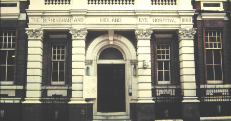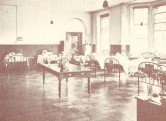1900s
 In 1909, a private ward block was opened.
In 1909, a private ward block was opened.
A further adjoining property in Barwick Street was purchased and by 1910 was in use as a nurses and domestics home.
During World War 1 (1914-1918), the hospital provided 40 beds to the military authorities for the care of military personnel.
In 1914 the hospital begun treating Belgian refugees suffering from disease or injury to the eye and used a house in Sparkbrook donated to the hospital to home the refugees.
After the war the hospital received a letter from the 1st Southern General Hospital, thanking the governors for their services rendered during the war.
When the new hospital was opened in 1884 a room had been set aside for pathological investigations but it wasn’t until 1913 that the hospital had the services of a pathologist; before 1913 tests had been performed by the dispenser and reports issued by the consultant surgeon.
In 1918 Dr. H. Black took charge of the X-Ray department and Mr W. Meggeson, the dispenser, acted as a radiographer.
By the early 1920s a hospital training scheme was run with prizes of one guinea and ten shillings and sixpence being awarded to the two best nurses in each intake.
1930s
In 1932 both The Midland Orthoptic School and the Orthoptic department were founded.
Burcot Grange was gifted to the hospital in 1936 for use as a recovery home; this brought the total number of beds to 146.
During the period between the World Wars the hospital increased the services it offered; however advances in medicine also saw the ophthalmia neonatorum (conjunctivitis of a newborn) ward and clinic, the ultraviolet ray clinic and the septic theatre became outdated and closed.
1940s
In 1939 a site had been agreed for a new hospital near the Queen Elizabeth Hospital however World War 2 prevented progress. Following the war in 1946, plans were made once again for the site and were again abandoned.
There were several attempts to close the Birmingham & Midland Eye Hospital completely and open small departments in all the district hospitals. This would seriously have affected the work that the hospital had been doing in advancing ophthalmology.
In 1944 the Biochemistry department was established by Dr Dorothy Campbell.
In 1948 the Opticians department was opened. At this same time the Migraine clinic began to evolve from the Research department; by 1949 Dr K.M. Hay had established the department as a separate clinic.
1950s
Ophthalmic Nursing became a recognised speciality in 1952 and the Ophthalmic Nursing Board for Great Britain and Northern Ireland were set up. The hospital was inspected and approved by this new board as a recognized Ophthalmic Nurse training school.
1960s
In 1962 the Glaucoma department was established and the Retina department evolved from the Research department.
During the 1960s the Pathology department gradually developed until in 1963 a Regional Consultant Pathologist was appointed.
1970s
In 1971 Orbital surgery was first performed at the Birmingham and Midland Eye Hospital.
1980s
In 1983 the Birmingham and Midland Eye Hospital celebrated 100 years since its founding; thanking the likes of Priestley-Smith for his work in Glaucoma and Harrison-Butler for his use of the slit-lamp for the advancements in ophthalmology that aided in the advancement and diverse technical skills the hospital had to date.
At part of the celebrations a commemorative brochure was produced allowing us an in-depth insight into the hospital and the services it offered at this time:
- Optician’s department – offering refraction, contact lens and low visual aids services.
- Regional Migraine clinic – offering treatment involving not only the use of drugs, and diet but also psychological techniques.
- Glaucoma department – working on detection and investigation of glaucoma.
- Retina department – carrying out clinical electrophysiological diagnostic tests on pre and post-operative cases.
- Biochemistry department – running routine biochemical investigations and some specialised tests which they provided for hospitals in different parts of the country.
- Orthoptic department – dealing with diagnosis and treatment of patients with defective binocular vision or abnormal eye movements.
- X-Ray department – offering, pre-operative screening, investigation of systemic conditions and casualty work.
- Pathology department – comprising of haematology, microbiology and histology laboratories.
- Pharmacy department – dealing with around 60,000 prescriptions per year.
- Medical Ophthalmology clinic – investigating and treating patients with disorders such as retinal vessel problems and eye tumours.
- Fluorescein angiography department – diagnosing retinal disorders, including those resulting from Diabetes.
- Laser therapy – used for the treatment of retinal conditions.
- Orbital surgery – offering ultrasonography for the detection of orbital lesions and ocular ultrasonography for the detection of intraocular conditions.
- Photography department – providing a clinical recording and teaching service to the hospital in pre-operative and post-operative case as well as in diagnostic fluorescein angiography
- Medical social worker department – for patients with any kind of visual difficulties providing a liaison with other social workers and local authorities.
In 1983 the hospital also had a range of support services including: The Medical, Nursing and Paramedical sectors
receive valuable back-up services from Administration/Clerical, Catering, Domestic, Portering and Works Staff.
Special clinics ran by the hospital in 1983 included: Cornea and specialised Ocular Trauma, Glaucoma, Medical Ophthalmology, Migraine, Neuro-ophthalmology, Ocular Motility, Oculoplastics, Ophthalmic Genetics, Retinal detachment/Vitrectomy and Ultrasonography/Orbital clinic.
In order to continue to provide excellent services the hospital took training and development seriously; in 1983 the hospital was the only undergraduate training centre for Ophthalmology in Birmingham. Nursing courses were also available for the Ophthalmic Nursing Diploma for Pre-registration and Post Registration Nurses, and the Ophthalmic Proficiency Certificate for Enrolled Nurses.
1990s
After 112 years at Church Street (1884-1996), the hospital moved to its current location at City Hospital on Dudley Road and was once more renamed as the Birmingham and Midland Eye Centre. The centre was officially opened on Friday, 28th June 1996 by HRH Prince Andrew.
-

Mr Roper-Hall narrates the story of BMEC
The namesake of the prestigious Roper-Hall prize, Mr Michael Roper-Hall, shares his story of the development of academic and research… read more



